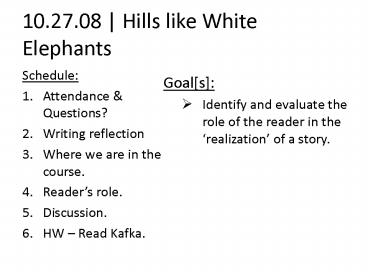10'27'08 Hills like White Elephants - PowerPoint PPT Presentation
1 / 10
Title:
10'27'08 Hills like White Elephants
Description:
... the role of the reader in the realization' of a story. Writing Reflection. ... In the short story, Hills Like White Elephants, addressed a critical issue on ... – PowerPoint PPT presentation
Number of Views:174
Avg rating:3.0/5.0
Title: 10'27'08 Hills like White Elephants
1
10.27.08 Hills like White Elephants
- Schedule
- Attendance Questions?
- Writing reflection
- Where we are in the course.
- Readers role.
- Discussion.
- HW Read Kafka.
- Goals
- Identify and evaluate the role of the reader in
the realization of a story.
2
Writing Reflection.
- After finishing a major project, it is good to
take a moment to reflect on what you have
accomplished and to think about what comes next.
Since we just finished our major paper, lets do
that now. - Answer the following questions in your notebook
- 1. What do you think of the paper you just turned
in? - 2. What aspects of your paper do you consider a
success? - 3. What aspects of your paper didnt turn out as
well as you would have liked? - 4. How can you build on your strengths to improve
your weaknesses? What can you do to move forward
and meet your writing goals?
3
Where are we?
- We have been focusing on immersion and how it is
produced by a variety of texts. Now we are going
to move on to consider some other
aspects/descriptions of the reading experience
that may challenge a notion of immersion.
4
Ryan recap.
- In the space-travel mode, represented by fiction
and now by virtual reality technology,
consciousness relocates itself to another world,
and recenters the universe around this virtual
reality. - Requires you suspend disbelief to accept virtual
world as real. - Key to this is transparency, because you have to
ignore the reality you know is true - possible-world and make-believe theories of
fiction presupposes a relative transparency of
the medium. The reader or spectator looks through
the work toward the reference world
5
As a result
- Ryans theory suggests that the readers
participation in the reading process needs to be
ignored. - She says we are so good at fiction reading we
fill in the gaps without noticing thats what we
are doing however - When the reader of a postmodern work is invited
to participate in the construction of the
fictional world she is aware that this world does
not exist independently of the semiotic activity
hence the loss in immersive power
6
- The most immersive forms of textual interactivity
are therefore those in which the user's
contributions, rather than performing a creation
through a diegetic (i.e. descriptive) use of
language, count as a dialogic and live
interaction with other members of the fictional
world. I am thinking here of children's games of
make-believe, and of those interactive
hypertextual systems where users are invited to
play the role of characters.
7
BUT
- Readers play an interactive role in whatever they
read. - You are the one holding the book, looking at the
printed page, imagining what is described. Thats
all on you.
8
Wolfgang Iserfrom the Johns Hopkins Online Guide
to Literary Theory and Criticism,
Reader-Response entry.
- Iser still assumes that the text establishes
norms guiding and limiting readers "The process
of assembling the meaning of the text . . . does
not lead to daydreaming but to the fulfillment of
conditions that have already been structured in
the text" (Act 4950) however, the texts
potentials, which include indeterminate gaps,
blanks, discrepancies, and absences, disturb the
structure and stimulate the readers activity
(9899). Readers synthesize "perspectives"
deriving from the texts narrator, characters,
plot, and explicit reader, but the text still
signals, guides, directs, and manipulates them,
moving them to reinterpret the text and, more
importantly, to produce what it cannot the
experience of a coherent, living whole growing
out of "the alteration or falsification of that
which is already ours" (9899, 132).
9
the readers role
- For the rest of the quarter, we will be talking
about the role of the reader. - What are you doing when you are reading?
- What role do you play in the creation of the
story? - What is your relationship to the text?
- How is that relationship set up by the text?
- Etc.
10
- In the short story, Hills Like White Elephants,
addressed a critical issue on abortion that
protagonists Jig and her American travel
companion (significant other) emphatically
discuss. Throughout the text, Jig wanted to carry
their baby to term however her companion wanted
her to abort their child, so they could continue
with their travel ventures. - Questions
- Does their conversation regarding abortion
heighten your interactivity within the context of
the story (with the characters, conversation,
etc.)? - Within your interactivity within the text, and
knowing how each character felt on this issue,
did you choose sides? If so which? And why? - Did you like how the story concluded? If so, did
this story leave you interactively engaged until
the end of the text?
- Since "Hills Like White Elephants" is a very
dialogue based story, why do you think Hemingway
found it important enough to describe the
scenery? Do you think there is any significance
in that there is a difference between the land
surrounding the train station and the land across
the valley?































